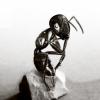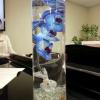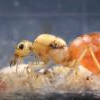- Formiculture.com
- Forums
- Gallery
- Members
- Member Map
- Chat

What's the strangest behaviour you saw?
Started By
Roachant
, Jun 17 2015 1:59 AM
9 replies to this topic
#1
 Offline
-
Posted June 17 2015 - 1:59 AM
Offline
-
Posted June 17 2015 - 1:59 AM
Hi all,
I was just curious after so many years of keeping and observing your formicariums, what is the weirdest thing you have seen your ants do, something unexpected or downright bizarre?
Don
I was just curious after so many years of keeping and observing your formicariums, what is the weirdest thing you have seen your ants do, something unexpected or downright bizarre?
Don
#2
 Offline
-
Posted June 17 2015 - 3:59 AM
Offline
-
Posted June 17 2015 - 3:59 AM
I saw a Myrmica rubra walking under water through the water barrier of their island nest.
![]() Franz
Franz
if you find any mistakes, it's my autocorrection. it doesn't speak english.
#3
 Offline
-
Posted June 17 2015 - 7:31 AM
Offline
-
Posted June 17 2015 - 7:31 AM
2 days ago I observed one of my Pogonomyrmex queens grab an egg as it was coming out from her gaster and immediately give it to a larva's open jaws. I am not sure if it actually was eaten or whether it was just misplaced after being delivered, probably the latter. I lost visual contact with what finally happened due to the position of the queen, etc.
What frustrates me is when the queen and her nanitics give their pupae to a larvae to be eaten, or when they apparently eat larvae. I can't understand what these ants are thinking, if they think at all. Perhaps there is an error in their DNA code that allows for spontaneous unexpected, irrational, 'ant'-i-biological behaviour.
#4
 Offline
-
Posted June 17 2015 - 9:24 AM
Offline
-
Posted June 17 2015 - 9:24 AM
This one is sort of a funny one:
I noticed that my Camponotus queen doesn't freak out when I look in on her ![]() This is usually very uncommon with this species as almost all of the ones I've kept freak out like their is an earthquake!
This is usually very uncommon with this species as almost all of the ones I've kept freak out like their is an earthquake!
#5
 Offline
-
Posted June 17 2015 - 9:25 AM
Offline
-
Posted June 17 2015 - 9:25 AM
2 days ago I observed one of my Pogonomyrmex queens grab an egg as it was coming out from her gaster and immediately give it to a larva's open jaws. I am not sure if it actually was eaten or whether it was just misplaced after being delivered, probably the latter. I lost visual contact with what finally happened due to the position of the queen, etc.
What frustrates me is when the queen and her nanitics give their pupae to a larvae to be eaten, or when they apparently eat larvae. I can't understand what these ants are thinking, if they think at all. Perhaps there is an error in their DNA code that allows for spontaneous unexpected, irrational, 'ant'-i-biological behaviour.
Coincidentally, I just scanned a paper on Pogonomyrmex this morning which stated eggs are sometimes laid to be fed to larvae. So maybe it's not that odd after all.
Camponotus vicinus, Crematogaster 1, Crematogaster 2, Formica francoeuri, *, *, Myrmecocystus testaceus, Novomessor cockerelli, Pheidole hyatti, Pogonomyrmex californicus, Pogonomyrmex rugosus, Solenopsis invicta
#6
 Offline
-
Posted June 17 2015 - 9:29 AM
Offline
-
Posted June 17 2015 - 9:29 AM
Coincidentally, I just scanned a paper on Pogonomyrmex this morning which stated eggs are sometimes laid to be fed to larvae. So maybe it's not that odd after all.2 days ago I observed one of my Pogonomyrmex queens grab an egg as it was coming out from her gaster and immediately give it to a larva's open jaws. I am not sure if it actually was eaten or whether it was just misplaced after being delivered, probably the latter. I lost visual contact with what finally happened due to the position of the queen, etc.
What frustrates me is when the queen and her nanitics give their pupae to a larvae to be eaten, or when they apparently eat larvae. I can't understand what these ants are thinking, if they think at all. Perhaps there is an error in their DNA code that allows for spontaneous unexpected, irrational, 'ant'-i-biological behaviour.
I have heard this as well, and it occurs in poison dart frogs as well, they lay eggs to feed tadpoles in bromeliad nests.
#7
 Offline
-
Posted June 17 2015 - 1:56 PM
Offline
-
Posted June 17 2015 - 1:56 PM
The oddest behavior I have seen usually has to do with the people collecting the queens and the lengths they sometimes go to. I think everyone has a few stories on that topic. ![]()
With ants in captivity, I often see neat behaviors that intrigue and interest me, simply because I would have been unable to view any of this in a wild nest. I love being able to observe the brood care.
Top of my strange behavior list? Older foraging members in Myrmica colonies, from the same nest, will occasionally start attacking one another. With 2-5 ants ending up dead every few months when this happens. I have seen this in every Myrmica colony I have ever kept.
One of my favorite behaviors is watching the workers helping a pupae when it is eclosing, especially neat with the cocoon spinning species. Or watching a more aggressive species launching a full on attack on their cut up piece of insect as if it were a deadly foe.
"Always do right. This will gratify some people, and astound the rest." -- Samuel Clemens
#8
 Offline
-
Posted June 18 2015 - 12:51 AM
Offline
-
Posted June 18 2015 - 12:51 AM
I once killed half my colony of C. clarithorax from what I believe to be an apple with pesticide still on its skin.
They started hanging out in the outworld and walking in circles. Painful to watch. They all slowly died.
Instagram:
nurbsants
YouTube
California Ants for Sale
Unidentified Myrmecocystus
https://www.formicul...ls-near-desert/
Undescribed "Modoc"
https://www.formicul...mp-ca-5-4-2017/
Camponotus or Colobopsis yogi:
https://www.formicul...a-ca-1-28-2018/
Camponotus us-ca02
https://www.formicul...onotus-us-ca02/
Unidentified Formica
https://www.formicul...l-ca-6-27-2020/
Pencil Case and Test Tube Formicariums
https://www.formicul...m-and-outworld/
Bloodworm Soup
https://www.formicul...bloodworm-soup/
#9
 Offline
-
Posted June 18 2015 - 2:35 AM
Offline
-
Posted June 18 2015 - 2:35 AM
In my summer vacation, I've been away for a week. I kept a Formica cunicularia and a Myrmica rubra colony next to each other. Due to the water loss, the leves of the plant between them began to hang down. One in the fouraging area of the Formica and one at the Myrmica's.
And as I came home again, they where struggling about the plants pot.
![]() Franz
Franz
if you find any mistakes, it's my autocorrection. it doesn't speak english.
#10
 Offline
-
Posted June 21 2015 - 8:19 AM
Offline
-
Posted June 21 2015 - 8:19 AM
Weirdest thing I saw was a wild Camponotus modoc biting on a woodchip,slowly dying with its organs coming out of its gaster despite no physical injuries and refusing to let go. I still haven't figured what was wrong with it.
The most unique behaviour is the recruitment technique used by a red Myrmica sp. found around Richmond,BC. Which, by the way this is how it works:
They're usually subterranean but when there's a fight like with their neighbouring Lasius niger colony or a food source some where a lot more workers are above ground and than a few workers (usually 3) walk in a single file line to the source of interest. On the way they "pick up"/recruit other workers and by the time they're at their destination they can have much as 13 workers.
EDIT: Just to add in does any body have an accurate data base for Myrmica species as they are really hard to identify. On my opinion they are one (and possibly) my favourite species due to it's very unique behaviour. I'm also really reluctant to dig up the nest in my backyard because before I even thought of keeping ants I would sit there and watch them for hours plus the colony seems to be thriving even after 3 or 5 years after it was discovered.
Edited by LC3, June 21 2015 - 8:24 AM.
0 user(s) are reading this topic
0 members, 0 guests, 0 anonymous users



















